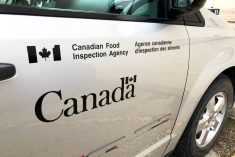(Reuters) — Questions about Roundup, the world’s most popular herbicide, are on the agenda at the U.S. Environmental Protection Agency Tuesday when regulators meet with a group of mothers, scientists, environmentalists and others who say they are worried about Roundup residues found in breast milk.
The meeting near Washington D.C., follows a five-day phone call blitz of EPA offices by a group called “Moms Across America” demanding that the EPA pay attention to their demands for a recall of Roundup.
“This is a poison and it’s in our food. And now they’ve found it in breast milk,” said Zen Honeycutt, founder of Moms Across America. “Numerous studies show serious harm to mammals. We want this toxic treadmill of chemical cocktails in our food to stop.”
Read Also

Women who fed a nation
More than 40,000 young women supported the war effort between the 1940s and early 1950s, helping grow and harvest crops amid labour shortages. They were called Farmerettes.
Roundup is a herbicide developed and sold by Monsanto Co. since the 1970s, and used in agriculture and home lawns and gardens. The chief ingredient, glyphosate, is under a standard registration review by the EPA. The agency has set a deadline of 2015 for determining if glyphosate use should continue as is, be limited or halted.
The agency expects to have a preliminary risk assessment completed late this year, said EPA spokeswoman Cathy Milbourn. She had no comment about the meeting Tuesday.
Monsanto says glyphosate has been extensively studied and has a long track record of safe and effective use.
But environmentalists, consumer groups and plant scientists from several countries have said in recent years that heavy use of glyphosate is causing problems for plants, people and animals. They say some tests have raised alarms about glyphosate levels found in urine samples and breast milk.
The critics say glyphosate is accumulating in the environment and is affecting human health. In 2011, U.S. government scientists said they detected significant levels of glyphosate in air and water samples.
The use of glyphosate in agriculture has jumped dramatically since the mid-1990s after Monsanto started introducing crops genetically engineered to withstand direct sprays of Roundup, so farmers could more easily kill weeds without harming their crops. Glyphosate is sprayed on most of the corn and soybean crops in the United States, as well as over sugar beets, canola and other crops.
Last year, the EPA agreed to raise the permitted tolerance levels for glyphosate residue in food. The agency said at that time that toxicity data and studies it reviewed shows glyphosate is not a cancer risk and is generally safe at the approved levels.
The U.S. Department of Agriculture routinely tests food for chemical residues to make sure they are within approved tolerance levels, but does not routinely test for glyphosate, citing budget restrictions and the lower health risks associated with glyphosate.














